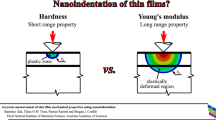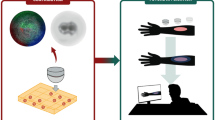Abstract
In the present paper the formulas for the stiffnesses of a new and more general surface tester concept are given and discussed. The concept is based on the idea that the next generation of surface testers will provide the means to use all degrees of freedom of movement a probe on a sample surface could perform. Thus, in addition to the ordinary normal stiffness, lateral and tilting stiffness are measured, as well as twisting stiffness, and then used in the subsequent parameter determination of the investigated materials. It is shown in the paper that such a concept would not only solve classical problems such as “pileup” and “sink-in” completely, but it would also supersede the need of area-function calibration for the indenter tips and allow direct measurement of local intrinsic and residual stresses, anisotropy, and many other things, too.
Similar content being viewed by others
References
W.C. Oliver and G.M. Pharr: An improved technique for determining hardness and elastic modulus using load and displacement sensing indentation experiments. J. Mater. Res. 7, 1564 (1992).
B.N. Lucas, J.C. Hay, and W.C. Oliver: Using multidimensional contact mechanics experiments to measure Poisson’s ratio. J. Mater. Res. 19, 58 (2004).
R.D. Mindlin: Trans. ASME, Series E. J. Appl. Mech. 16, 259 (1949).
K.L. Johnson: Contact Mechanics, 4th ed. (Cambridge University Press, Cambridge, UK, 1985), pp. 1, 211–219.
N. Schwarzer: Basic Equations for the Next Generation of Surface Testers for the Case of an Elastic Indenter and a Layered Samples, online archive of the Saxonian Institute of Surface Mechanics, www.siomec.de/pub/2008/001.
V.I. Fabrikant: Mixed Boundary Value Problems of Potential Theory and Their Application in Engineering (Kluwer Academic Publishers, The Netherlands, 1991).
N. Schwarzer: Short note on the potential use of a rotating indenter with respect to the next generation of nanoindenters. Int. J. Surf. Sci. Eng. 1, 239 (2007).
N. Schwarzer: Effect of lateral displacement on the surface stress distribution for cone and sphere contact. Philos. Mag. 86, 5231 (2006).
N. Schwarzer: Intrinsic Stresses—Their Influence on the Yield Strength and Their Measurement Via Nanoindentation, online archive of the Saxonian Institute of Surface Mechanics, www.siomec.de/pub/2007/001.
Author information
Authors and Affiliations
Corresponding author
Rights and permissions
About this article
Cite this article
Schwarzer, N. Some basic equations for the next generation of surface testers solving the problem of pileup, sink-in, and making area-function calibration obsolete. Journal of Materials Research 24, 1032–1036 (2009). https://doi.org/10.1557/jmr.2009.0077
Received:
Accepted:
Published:
Issue Date:
DOI: https://doi.org/10.1557/jmr.2009.0077




